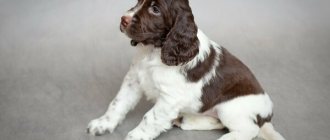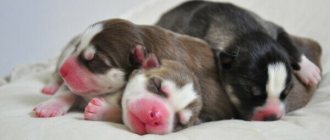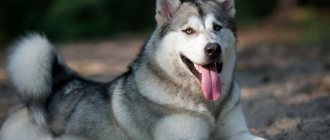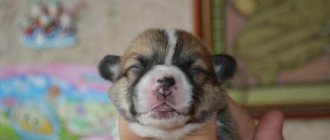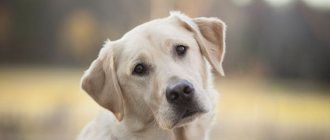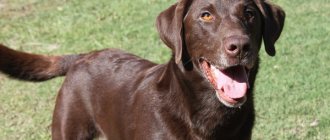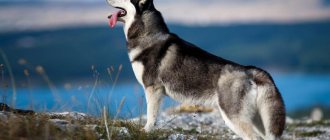Perhaps you are purchasing a dog only for hunting, do not plan to participate in exhibitions, etc. events, but in any case you should pay attention to several points when choosing and buying a puppy.
You are acquiring a living creature that will live in your family for more than ten years. This choice is final: you cannot throw it away if it no longer satisfies you, like throwing out an old washing machine. The choice of a puppy must be taken very seriously.
Types of puppies and their descriptions with photos
Spaniels are smart, quick-witted, loyal, sociable and friendly dogs that are quite easy to train..
There are many varieties of this breed, but the most common are English, American and Russian spaniels.
English
The first representatives of this breed were much larger than modern ones . To reduce their size, these dogs were mated with Japanese spaniels presented to the Queen of England.
This is how English spaniels were bred, distinguished by their more compact size, mobility, endurance and developed sense of smell.
These dogs are distinguished from American and Russian spaniels by their body proportions, as well as the size and shape of their heads.
“English” - owners of a dense physique with well-developed muscles, a short body, strong strong limbs and a slightly convex and flattened head in front.
Representatives of this breed grow to 34-41 cm at the withers and weigh 12-16 kg. Puppies of this breed reach their maximum height at about one year of age.
These dogs have a long, silky and thick coat, without curls, waves or curls. From time to time, these dogs need a haircut.
American
This variety is the descendant of the English spaniel, so their appearance is quite similar. “Americans” are slightly smaller in size, growing at the withers to 35-39 cm with a body weight of 12-14 kg.
These dogs have large expressive eyes, a shorter muzzle and a clearly defined transition from the forehead to the muzzle..
The coat of American Spaniels is longer, thicker and more luxuriant, with curls of hair on the ears, belly and chest.
These dogs have a developed hunting instinct, but are now more often used as a decorative breed.
Russian
Russian spaniels have collected the blood of different types of spaniels..
The goal of Soviet breeders was to develop a breed that would be most suitable for hunting in Russian conditions, therefore representatives of this breed have a slightly longer body and limbs - this makes galloping easier in difficult places.
The height of Russian spaniels at the withers is 36-44 cm, weight - 13-18 kg . They have a light, slightly convex head at the sides and an almost rectangular profile. The coat is of medium length and density. The color can be varied - black, red, brown and others.
Hunting qualities
The Russian Spaniel dog breed is endowed with a whole set of qualities that are indispensable for hunting:
- versatility: the spaniel “works” with almost any type of game;
- compactness: the small size and weight of the spaniel help him to easily get through places where a large dog would get stuck;
- high performance in any weather conditions: the spaniel is not afraid of heat (like, for example, a cop) or complete calm;
- rapid achievement of “hunting” age: a puppy of the autumn litter, with proper training, goes on its first hunt by spring-summer;
- keen sense of smell: the dog will not make a mistake when searching for a wounded animal or a hidden bird; it will find prey in the thickets, in the dark.
Basic rules of care
Despite the fact that newborn puppies are completely helpless, their eyes and ear canals are closed and they lack their own thermoregulation, caring for them requires minimal effort on the part of the breeder, since the main concerns fall on the bitch.
IMPORTANT!
All that is required from the owner is to ensure that they are well-fed, supplementing them with a bitch milk substitute if necessary, and also control their temperature, which normally should be 34.5-36 °C.
If the litter is separated from the bitch, the temperature in their bed must be maintained at least +30 °C, otherwise the puppies may freeze and die.
How to bathe properly
Spaniels cannot be bathed until the quarantine period ends after the last vaccination. The exception is cases when the puppy is very dirty, but it is better to try to minimize the likelihood of this.
During the first bath, you should lay a rubber mat on the bottom of the bath so that your pet’s paws do not slip, and cover your ears with cotton swabs, eliminating the possibility of water getting into them..
The coat of representatives of this breed should be brushed 3-4 times a week, or better yet, daily. This will help get rid of dead hair and avoid the formation of tangles.
Claws
For the first time, puppies' nails need to be trimmed around the 8th day after birth to prevent them from scratching their mother's nipples, then repeat the procedure weekly, cutting off sharp edges.
Adult dogs' nails should be trimmed once every 3-4 weeks..
Eyes
These dogs are prone to eye inflammation. To avoid this, you need to wipe the puppies’ eyes daily with a cotton pad soaked in chamomile infusion or boiled water.
If there is increased lacrimation, purulent discharge or photophobia, you should contact your veterinarian.
Ears
Spaniels have long, drooping ears, which helps protect the ear canals from foreign objects entering them, but at the same time causes poor ventilation and, as a result, increases the risk of developing inflammatory diseases.
Ears should be cleaned once a week using cotton swabs and a special product that helps soften and remove wax, and ventilate daily, minimizing the risk of pathologies..
Water
In addition to a properly selected and balanced diet, the dog needs a sufficient amount of fluid, otherwise the risk of dehydration increases.
The main rules for watering a puppy:
- keeping the bowl freely available;
- cleanliness of the liquid;
- regular water renewal;
- compliance with the temperature regime – 20-25 degrees;
- systematic cleaning of dishes.
Dog trainers recommend choosing bottled or filtered water for your puppy. It is better to refuse boiled, raw is strictly prohibited.
How to toilet train
The puppy cannot be taken outside during quarantine after vaccinations, so it is important to accustom him to the toilet in the house so that he does not shit in inappropriate places.
The most effective way is to limit the pet’s space by allocating it a separate room or part of the room, where the floor will be completely covered with sanitary diapers or newspapers..
This will not allow the puppy to relieve itself by. Gradually you need to reduce the number of diapers, leaving only 1 at the end, which over time can be moved to the place reserved for the toilet.
If it is impossible to limit the dog's space, it is necessary to spread diapers throughout the apartment or house, especially near doors and windows.
It often happens that a puppy, despite all the diapers, goes to the toilet in a certain place that, for some reason, he chose on his own; in such a situation, it is important to lay the diaper there, even if it is not entirely convenient for the owner.
When the pet gets used to relieving itself on the diaper, it can be moved to another place.
CAREFULLY!
The puppy should be taken to the diaper after sleeping, eating and active games and should not be allowed to leave until he relieves himself.
You can use special sprays, the effect of which is aimed at toilet training your pet - they need to be sprayed on a cloth or piece of paper and placed on a diaper.
The spray emits a specific aroma that is captured by dogs' sensitive sense of smell, indicating the correct place for the toilet..
After the end of quarantine, your pet can be trained to use the toilet outside. To do this, the dog needs to be taken for a walk in the morning and every 40-60 minutes. after feeding and wait until he goes to the toilet.
Character of the Russian Spaniel
Persistent and tireless in work, in a home environment the Russian hunting spaniel is transformed, transforming into a pleasant, good-natured pet. Moreover, with this shaggy psychotherapist you can always whisper about secrets or spend the evening watching the “Hunter and Fisherman” channel. In everyday life, a Russian spaniel doesn’t care what to do, as long as it doesn’t lose contact with its owner.
Even into adulthood, representatives of the breed retain puppy playfulness and interest in entertainment. This helps them join children's groups, in which long-eared gamers feel like fish in water. By the way, dogs do not conflict with babies, generously forgiving her for minor harms like pulling her tail and ears.
The Russian Hunting Spaniel's favorite games are fetching all kinds of balls and, of course, searching for objects, so don't be lazy to devote at least 10-20 minutes a day to your pet's hobbies. However, you don’t have to do this, but then you need to calmly accept the fact that the dog will have fun on its own. Typically, Russian hunting spaniels compensate for the lack of play with destructive behavior, so just to be on the safe side, hide your Nikes and Adidas shoes away. Spaniels love to chew leather products and anything that even slightly resembles it.
The breed has a very developed intuitive sense: its representatives easily detect changes in the owner’s mood, understand any requirement at a glance, and masterfully differentiate all people into good and suspicious people. If a spaniel growls with enviable consistency at one of your old friends, there is reason to think about it.
What to feed for the first 3 months?
For at least 2-3 weeks, and preferably 30-40 days, the main food for puppies should be mother's milk.
The exception is when this is impossible for some reason, then the breeder needs to feed the entire litter himself, using unsweetened and lactose-free infant formula or, better yet, special bitch milk substitutes, for example, Royal Canin Babydog Milk.
After the main lactation period, i.e. about a month after the puppies are born, they need to start giving complementary foods in the form of ground vegetables, fermented milk products or soaked dry food.
NOTE!
The amount of complementary feeding should be gradually increased by adding new products, including boiled ground beef, low-fat broth, some offal (heart, lung, liver) and porridge cooked in broth.
At 2 months, the puppy should be familiar with most of the foods allowed for spaniels in order to be as prepared as possible for moving to a new home.
New products must be introduced into the menu gradually, observing how the puppies’ bodies react to them and whether there are any negative reactions.
Story
The lack of a dog suitable for the Russian climate forced breeders to think about independently breeding a suitable breed. They selected the longest-legged representatives of the breed, imported sprinters from Europe in order to improve the livestock with their blood. This process was repeated over several breeding periods, resulting in spaniels that did not fit the standard English breeds.
By the thirties of the last century, Russia had many dogs that did not fit the standards of the breeds available at that time, but had common characteristics. Nevertheless, it was too early to talk about the emergence of a new breed that would meet the needs of hunters.
Full breeding work began after the Second World War, and in 1951 the original breed standard was introduced. The final, slightly modified standard appeared in 1966.
How to feed correctly and how often
The main thing to remember when choosing food for a puppy is that the diet should be balanced and contain all the vitamins and minerals necessary for healthy growth and development.
As the puppy grows up, not only its diet changes, but also its diet and the number of feedings per day, replenished with new products.:
- up to 2 months of puppy – 6 times;
- 2-4 months – 5 times;
- 4-6 months – 4 times;
- 6-10 months – 3 times;
- after 10 months – 2-3 times.
Improper feeding, deprived of essential macro- and microelements, often causes the development of dangerous pathologies.
Weekly menu for a 4 month old puppy
| Day of the week | Menu |
| Monday | Oatmeal and buckwheat porridge with vegetable oil, stewed vegetables, boiled veal, natural yogurt |
| Tuesday | Rice porridge with stewed vegetables, boiled beef, sour cottage cheese, boiled egg, buckwheat porridge in broth |
| Wednesday | Oatmeal, calcined cottage cheese, boiled sea fish, low-fat kefir, finely chopped zucchini, bell pepper and carrots |
| Thursday | Rice porridge with vegetable oil and stewed pumpkin, natural yogurt, calcined cottage cheese, beef offal |
| Friday | Buckwheat porridge with stewed vegetables, kefir, boiled turkey, calcined cottage cheese |
| Saturday | Oatmeal, boiled beef and turkey, boiled beets, natural yogurt |
| Sunday | Rice porridge with boiled beets and fresh bell pepper, boiled beef, calcined cottage cheese, boiled egg, buckwheat porridge in broth |
Prohibited Products
A balanced menu means feeding your dog healthy foods while excluding prohibited foods.
The list includes:
- raw cabbage;
- millet cereal;
- semi-finished products;
- avocado;
- spices, pickles, smoked, fatty foods;
- bones of rabbits and chickens;
- pork;
- river fish and any types of raw fish;
- mushrooms.
Onions and garlic are conditionally prohibited foods - they can be given occasionally. In addition, cold and hot food, as well as food prepared from expired ingredients, are harmful.
If you follow these rules, then raising a healthy, cheerful and active dog is very simple. Another important condition is sufficient attention to the pet.
Vaccination schedule
| Age | Nobivak vaccine | Eurikan vaccine |
| 7 weeks | Deworming | |
| 8-9 weeks (vaccination against plague, viral hepatitis, adenoviral infections, parvovirus enteritis, parainfluenza, leptospirosis) | DHPPiL | DHPPI2+L |
| 11 weeks | Deworming according to indications | |
| 12 weeks (vaccination against plague, viral hepatitis, adenoviral infections, parvovirus enteritis, parainfluenza, leptospirosis + rabies vaccination) | DHPPiL+R | DHPPI2+RL |
| 1 year | DHPPiL+RL | DHPPI2+RL |
| Vaccinations are then repeated annually at the same time. |
Features of hunting
A Russian Spaniel on the hunt is a specialist in various types of game birds. A four-legged hunter on a hunt looks for a bird in places that are difficult for the hunter to reach, lifts it “on the wing”, and then, after shooting, brings back the prey.
Types of hunting with a spaniel:
- duck hunting;
- snipe and snipe hunting;
- corncrake hunting;
- hunting for black grouse and wood grouse.
Duck hunting
It is believed that this breed owes its appearance to duck hunting: it was originally bred to hunt waterfowl.
The specifics of the hunt are as follows:
- hunting time: spring - autumn;
- place: meadow swamps, lake shores;
- process: the dog walks ahead of the owner, moving near the water, through overgrown areas. Having found a hidden duck, the spaniel lifts it onto the “wing” and exposes it to the hunter’s shot, then searches for a dead bird or dives for a wounded animal. Without the participation of a dog, a large percentage of wounded ducks hide in the thickets and go to places inaccessible to the hunter.
Snipes and snipes
Many lovers of “beautiful” hunting prefer spaniels to pointers in the hunt for this game. The spaniel does not “stand”, but works expressively and emotionally - so that even before the bird takes off, an experienced hunter will prepare a shot.
Specifics:
- time: August – early September;
- place: floodplain meadows, sedge bogs in the predawn;
- process: the dog moves “short”, “shuttle”. Sensing game, the dog freezes and tries to lead the owner to the bird before it takes off.
Landrail
The main feature of the bird is its “laziness” - it is extremely reluctant to take the wing, preferring to exhaust the dog by running. That is why the “stand” of a pointer does not cope well with a jerk, but a hardy and active spaniel works well.
Specifics:
- time: mid-September;
- place: the banks of meadow lakes and ravines, the border of mown meadows;
- process: the spaniel “chases” the corncrake in circles, sometimes for half an hour or more. With his voice, “candles,” and jumping, he finally lifts the stubborn bird “on the wing.”
Black grouse and capercaillie
Black grouse and wood grouse are very shy and cautious birds, so the main thing in hunting them is not to scare off the game ahead of time. Only the most “professional” dogs – seasoned and patient – are suitable for this hunt.
Specifics:
- time: autumn;
- place: forest glades, wastelands, overgrown fields;
- process: the dog is in constant close contact with the person, bringing him close to the prey. Having taken the scent, the spaniel goes around the bird from the side and directs it directly under the hunter’s gun.
The pet is also taken for other types of hunting: for example, hare, trotter, white hare, and sometimes even wild boar. Possessing a real “hunting passion”, this four-legged hunter will make any hunt exciting and rich in prey.
The character and abilities of a dog largely depend on the person. The owner's caring and attentive attitude towards the pet will help it become an indispensable companion, both on the hunt and in everyday life.
How to train correctly and what commands to teach?
Spaniels are intelligent dogs that are easy to train . Puppies quickly adapt to new conditions, adjusting to the rules established in the house and the owner’s lifestyle.
However, they need proper upbringing; you should not expect that the pet will learn everything on its own.
There are several basic recommendations that need to be taken into account when raising a spaniel.:
- It is best to start training when the puppy is 5-6 months old, this is the optimal time until the dog’s character is fully formed;
- It is necessary to work with your pet regularly - this is the only way to achieve positive results in the shortest possible time;
- The spaniel should be provided with sufficient physical activity and training should begin when the pet is reasonably tired, so as not to be distracted from activities;
- It is better to conduct training in a playful way;
- you cannot shout at the puppy or hit him;
- For correct execution of a command, the pet must be rewarded with praise and treats.
Representatives of this breed are friendly towards everyone, so it is necessary to show the puppy that he needs to behave with restraint with strangers, do not allow him to jump on passers-by or sniff them.
It is also important to teach your dog at least basic commands . First of all, you need to accustom your pet to its nickname, saying it out loud as often as possible when addressing it.
After the puppy begins to associate himself with the chosen name, you need to teach him the “Come to me” command, calling the spaniel by name and treating him with a treat when he comes.
You should also call him by name before feeding - this will help reinforce the dog’s positive associations with this command.
Place training is another important command . You should arrange a personal place for the dog where it will sleep and take the puppy there, saying the command “Place”.
When the baby remembers this and clearly understands where exactly his personal place is, this command can be a little more complicated: you need to leave the pet in any other place, say the command and leave, making sure that the puppy does not follow.
It is also important to master the commands “Fu” and “No”, pronouncing them loudly and clearly when the pet does something forbidden; at the same time as the command, you can take it by the withers and shake it slightly.
For the “Sit” command, you need to show the puppy a treat so that he raises his head and sits down; you can easily press on his croup and clearly pronounce the command.
Using the same principle, the “Lie down” command is mastered, only the puppy’s position changes..
In addition, it will not be superfluous to master the commands “Give me your paw”, “Nearby”, “Show your teeth”, and hunting dogs also need to be trained in fetching.
Choice
The first thing you need to pay attention to before examining puppies is their mother . The buyer has the right to ask for a dog’s passport to make sure that it is healthy and does not have any abnormalities. The mother of the dogs must be in excellent condition. If she is lethargic, sickly, exhausted, this can affect her offspring.
The second is age . You can buy a spaniel only after he is 6-8 weeks old. At this age he is already independent and can survive without his mother. But if the puppy is still too small, he may begin to get sick away from his mother, become weak, and training will be difficult, because they always learn the basics from their mother.
Next is character . Despite the similar traits of Cocker Spaniels, each puppy is completely unique. Some are mobile, active, others bark a lot, others prefer calm and are afraid to be handled. Therefore, before the final purchase, you should make sure that the animal is to the liking of all family members. And in order not to make a mistake, you need to watch the kids a little. You can visit the breeders several times, see how the puppies behave, and choose the one who is closest in habits and appearance.
And finally - inspection . The puppy must be completely healthy. Small cocker spaniels should have strong paws, a symmetrical body, clear skin, and a shiny, silky coat. You also need to check the paw pads for diseases and wounds, the beauty of the claws, as well as the muzzle. The eyes should be clean without pustules, the nose should be wet and cold, the gums should be pink. A puppy of 6-8 weeks already has formed, white teeth.
Popular nicknames for boys and girls
| Gender of the dog | Names |
| Male | Lorrie, Maurice, Tom, Neil, Archie, Luke, Mars, Oscar, Casper, Colin, Dani, Patrick, Barney, Dani, Bruno, Leo, Kevin, Monty, Simon, Derek, Watson, Bruce, Lucky, Tiktak, Chaplin, Elwood, Latte, Mickey, Twister, Elvis, Hustler, Rocky, Wally, Pancho, Ripley, Ozzy, Hiro (generous), Ren (lotus), Akira (bright), Arata (new), Yuki (snow), Haruki (shining ), Hayato (falcon), Hikari (light), Hinata (sunflower), Akito (autumn) |
| Bitch | Dolly, Sarah, Doni, Chloe, Trixie, Floris, Laura, Mimi, Irma, Christy, Dekla, Dori, Pixie, Eileen, Jena, May, Ruby, Cheri, Nancy, Lily, Betsy, Isa, Grace, Kira, Belle, Wendy, Linda, Sabina, Alice, Penelope, Sophie, Puma, Bridget, Snowball, Margo, Bagheera, Cleo, Sima, Lipa, Lada, Toffee, Fifa, Sabrina, Shinju (pearl), Kiku (chrysanthemum), Aimi (beautiful love ), Haru (spring), Natsumi (beautiful summer), Yuri (lily), Sakura (cherry blossom), Hoshi (star), Nami (wave) |
Breed characteristics
| Short description | |
| Origin: | Russia |
| Conditions of detention: | House with or without garden, apartment |
| Purpose: | Hunting dog, companion dog |
| Color: | Solid solid black, tan or chocolate brown, white markings acceptable |
| Wool length: | Long |
| Adult dog size: | Female height – 36-42 cm, male height – 38-44, weight – 15-20 kg |
| Average life expectancy: | 10-12 years |
| Walk: | Need active walking twice a day |
| Physical activity needs: | High physical activity needs (1.5-2.5 hours of walking or training) |
| Classification of the Russian Cynological Federation (RKF): | Group 8: Retrievers and Gun Dogs, Section 2: Gun Dogs |
| Puppy price: | From 3,000 to 20,000 rubles. Without pedigree – 3000-5000 rubles, pet class – 10000 rubles, breed class – 15000 rubles, show class – 20000 rubles |
When is a puppy separated from its mother?
Newborn puppies depend on their mother to not only feed them, but also to keep them warm and lick them, stimulating defecation and urination..
Over time, the connection between the puppies and the bitch weakens - already about 14 days after birth, the babies’ eyes and auditory canals open and they begin to explore the world more independently.
Until about 30-40 days, the only food for puppies is bitch's milk, but already at the age of one month it is necessary to begin gradually introducing complementary foods gradually.
This means that small spaniels finally cease to depend on their mother and become completely independent.
Once the puppies reach 8 weeks of age, they are ready to go.
At 8-12 weeks they are independent, do not depend on their mother, but they have not yet developed behavioral habits, and their psyche, character and behavior are quite flexible, so babies adapt as easily as possible to a new home, easily remember the rules of behavior and are amenable to training.
Adviсe
- In almost every litter there is one weakest and puniest puppy. It is highly not recommended to take it, because there is a high probability of serious health problems. But it doesn’t happen once in a while. Everything here directly depends on the quality of keeping and caring for the animal. Often it is these puppies that grow up to be large, strong dogs that are extremely rarely susceptible to disease.
- Cocker spaniels are very smart animals. They usually understand what is required of them, but will only learn if given encouragement. If the training method is chosen correctly, the dog will learn commands very quickly.
- Cocker spaniels can gain weight quickly. They rarely control appetite, which leads to obesity in the animal. So, from puppyhood, owners must accustom their four-legged friend to a proper diet and strictly control what the puppy eats and in what quantity.
- The problem of all cocker spaniels and their main advantage is their eyes. Tender pleading, plaintive eyes will always beg for food from the owners, but by succumbing to provocation, the owner will only make things worse. It is important to remember that this breed should not overeat. And human seasoned food is extremely harmful for them.
Mating
Dogs can be untied at the age of 20-25 months, although puberty comes much earlier (8-10 months). It is during this period that the female will go into her third heat, and a loose loop and light discharge will be a signal that the girl is ready.
To officially transport the breeding, owners need to fill out certificates and forms at the nursery. The male is selected in advance, the owners agree on the date and price, which is usually equal to one puppy or a percentage of its cost.
Pets must be checked for pathologies and diseases and undergo deworming 2 weeks before mating.
Spaniels are not large, they do not need much space. The pets are introduced, walked together, and brought to the dog’s territory. Here the boy will feel relaxed and free. If the female is calm and everything suits her, then the male will be able to make a cage. Otherwise, you need to give the dogs more time or try another day.
Sexual intercourse lasts from 10 to 15 minutes , during which time the animals are helped not to lose their balance: the girl is held under the stomach and by the head, the boy is guided into a noose. You can invite a specially trained person. In the absence of a lock, the female can be fertilized. The fixative mating is carried out after 2 days .
Read a detailed article on the topic: “Everything you need to know about breeding dogs: appropriate age, what to do if it doesn’t work out, rules and tips.”
Reviews from breed owners
Reviews about the breed are mostly positive . Owners describe Spaniels as loyal and obedient hunting dogs, but believe they are not suitable for everyone.
- The first disadvantage is excessive activity and the need for frequent long walks.
- The second is a lot of wool.
- The third is diseases.
Thus, the owner of an adult Spaniel, Irina, writes: “These pets are unpretentious in their maintenance, survive frosts well, and eat everything. Very bright both in appearance and in character. They are loving, affectionate, playful, and are completely devoted to serving their owner. Indispensable during hunting. But they need careful care, especially for ears and fur. Dogs are very active and can be destructive. Without education, they become leaders in the family.”
Another owner believes that all dogs are worthy of attention and respect, but Russian spaniels are special: “You immediately fall in love with the eyes of this pet. You may not like animals, but a dog of this breed will win your heart. Our pet is loyal, playful, active. The only genetic drawback is frequent illnesses and epileptic seizures.”
